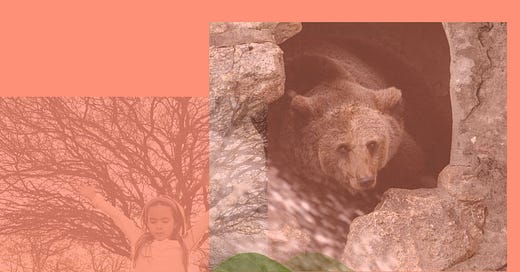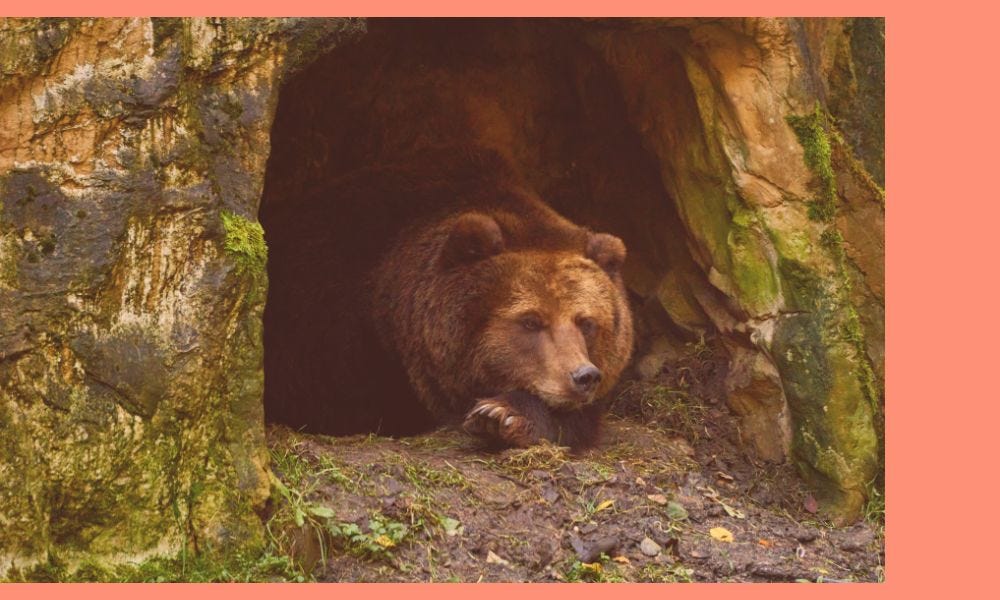‘Oh god, that sounds terrifying’, my mum said when I told her about the exercise I was planning for my next workshop. She’s not at all shy or reserved, but something about it made her recoil. ‘We had a teacher at school who made us do “movement” classes – we had to pretend to be trees’, she shuddered.
I laughed, recognising that familiar resistance I’ve encountered so many times when describing this kind of work. The same resistance I felt myself, years ago, before I understood why I would end up working so damn hard to be able to do things like pretend to be a bear.
Let me explain. The other day, I ran an online session where we explored a practice connected to Artemis who was a protector of young girls, amongst other things, in Greek mythology. In the original rite, groups of girls would venture into the forest wearing bear skins – like prehistoric cosplay – as part of a coming-of-age ceremony. Under the watchful eyes of their elders, they’d transform into wild creatures, dancing and connecting with their wild side and with nature, discovering their own power in the safety of the group.
In our modern version, we used blankets and coats instead of bear skins. But the transformation remained. Our blankets became costumes that invited a different way of being, as well as shelters we could retreat into whenever we needed. The blanket could become a dark, soft bear cave in an instant. Sometimes that cave is comforting, at others its quiet cut-off cosiness can feel like a familiar trap, easy to get stuck in. It can be a welcome pause or a place of restlessness. Every response reveals something about how we navigate the dance between safety and risk.
I share this knowing it might sound absurd or terrifying to you. But this kind of gentle and playful embodied exploration helped me shift long-held patterns and discover more expansive ways of living – all while having a lot of fun, feeling pretty ridiculous and learning the life-enhancing skill of being able to laugh at myself! The simple act of transformation through costume – even just a blanket – can unlock something profound.
There’s a reason coming-of-age rituals have existed across ages and cultures. They offer a container for testing our edges while knowing we’re held safe. Modern life rarely gifts us this kind of protected bold exploration. We’re often expected to simply dive into the deep end, risking over-exposure – or to forever hold back in fear of it – without building the bodily wisdom that tells us we can handle it. No wonder it can feel overwhelming.
This delicate balance between safety and brave risks is crucial. We need to build self-trust gradually, collecting evidence in our muscles and bones that we can take these leaps and land safely. This is where seemingly simple exercises – yes, even pretending to be a bear – can create subtle but lasting shifts.
Over and over, I’ve watched people discover entirely new ways of moving, of holding themselves, of letting their voice ring out with a new quality. These discoveries don’t stay in the workshop room. They walk out the door with you, into work meetings, relationships and creative projects. They quickly become part of your lived experience, expanding what feels possible.
Over the years, I’ve noticed something curious about how people react to hearing about this kind of work. Friends or family who are chatty, extraverted, confident – those who I used to measure myself against at times and judge myself lacking – would often say: ‘Oh my god, you’re so brave, I could never do that!’
It used to surprise me. Now it mostly makes me feel proud. It took me a long time to acknowledge that I have always been brave – not weak, not less than, not just a person who didn’t quite know how to be a person. But I know now that I am bold and brave, even – and sometimes especially – when I am quiet. As I’ve plastered colourfully on my website: shy is not the opposite of brave. And here’s a perfect illustration of that. Maybe most people are scared of pretending to be a bear, but the shy ones – or some of us – are brave enough to try anyway.
I realise now that I didn’t ask my mum what was so awful about that ‘be a tree’ exercise for her. Maybe she just felt silly. But, if it was me reflecting back on a similar school-age shudder-inducing memory, I think there’d be stuff to explore around safety, about being seen, feeling self-conscious, body-conscious, wanting to be cool or accepted by my peers, wanting to impress the teacher, and the difference between being made to do something and being invited into it with care and context.
I’ve always been inspired by the idea of wisdom passing between generations, even as we reimagine what that might look like. The ancient ritual of girls being guided into their own power under the protective gaze of their elders speaks to something we often lack today. We all need someone looking out for us, believing in us, helping us realise we’re capable of more than we think.
So here’s an invitation
Start small. Maybe pretending to be a bear, or a tree in the foreset, feels like too much to start. That’s completely okay. Perhaps begin with just one finger being a leaf in the wind. Close your eyes. Let that finger explore what it means to be carried by a breeze, to flutter, to fall, to rise again. Take a minute with just that much.
If you’re curious to go further, find a blanket or big coat – something that can envelope you completely. Put some forest-y music in your ears (or silence, if you prefer). Let the fabric become your bear skin. Notice how it feels to be hidden, protected. Then, if you want to, begin to explore:
Sniff the ground with your bear nose, rootling through damp leaves
Lumber slow and heavy through the trees, channelling your inner Baloo
Play and tumble in the dirt like a cub
Sit still and ponder, doing your best Pooh impression
Swipe with your big paw, snuffle or roar
Remember, you can transform your bear skin into a cave whenever you need to rest or retreat. There’s no wrong way to do this. Whatever emerges – resistance, silliness, discomfort, doubt, delight, awkwardness, frustration – is information about how you move between safety and risk, between hiding and playing, between expression and introspection.
And if you try any of this – even just the leaf-finger dance – I’d love to hear about it. What happened? What did you discover? Sometimes the smallest movements can unlock the most unexpected treasures. 🍃
That’s why I learned to pretend to be a bear – not to perform or impress, but to understand myself better, to make friends with my own wild and tender places, to expand what feels possible, one playful experiment at a time.
Maybe my mum would still hate it. Maybe you will too. But maybe, like me, you’ll discover something surprising in the simple act of pretending to be something other than your current everyday self. Something that helps you feel more at home in expressing who you actually are.





